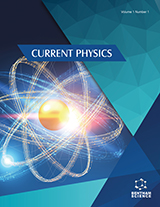Abstract
Background: In this paper, we propose solving the specific original problem of control synthesis of spacecraft attitude. Optimization of the control program is made with the use of a new criterion of quality that combines energy costs and duration of reorientation under restrictions on control (the presence of a time factor limits the duration of slew maneuver).
Methods: The construction of optimal control for angular momentum change is based on the quaternion method and L.S. Pontryagin maximum principle. An analytical solution to the problem was obtained on the base of a differential equation relating the orientation quaternion and angular momentum of a spacecraft.
Results: Key properties of the optimal solution are formulated in analytical form; the features of optimal motion are studied in detail. The control law is formulated in the form of explicit dependence between control and phase variables. In a case when the controlling torque is limited by the given restriction (at the beginning and end of a turn), analytical formulas have been written for the duration of braking and acceleration. Main relations which determine optimal values of parameters of the algorithm for control of angular momentum are given. Examples and results of mathematical modeling of spacecraft motion formed by optimal control were given. This data in addition to the theoretical descriptions illustrates the process of reorientation in evident form and demonstrates the practical feasibility of a designed method for control of angular momentum during spatial turn.
Conclusion: The designed optimal algorithm of control of spacecraft motion improves the efficiency of spacecraft attitude system, and originates more economical performance of spacecraft during flight on orbit.
[http://dx.doi.org/10.2514/3.20515]
[http://dx.doi.org/10.2514/3.21187]
[http://dx.doi.org/10.2514/2.4053]
[http://dx.doi.org/10.2514/3.21031]
[http://dx.doi.org/10.1134/S1064230708060117]
[http://dx.doi.org/10.2514/2.4436]
[http://dx.doi.org/10.1134/S1064230707020189]
[http://dx.doi.org/10.1134/S1064230710060079]
[http://dx.doi.org/10.15226/2474-9257/2/4/00121]
[http://dx.doi.org/10.17587/mau.16.188-195]
[http://dx.doi.org/10.3103/S0025654416020011]
[http://dx.doi.org/10.1134/S1064230718010069]
[http://dx.doi.org/10.1134/S1064230711010138]
[http://dx.doi.org/10.3103/S0025654409020022]
[http://dx.doi.org/10.1134/S1064230719040105]
[http://dx.doi.org/10.15406/iratj.2018.04.00159]
[http://dx.doi.org/10.15406/iratj.2021.07.00228]
[http://dx.doi.org/10.1080/14786435.2018.1547431]
[http://dx.doi.org/10.1038/s41598-021-97684-8] [PMID: 34526572]
[http://dx.doi.org/10.1002/aelm.202101124]
[http://dx.doi.org/10.1016/j.mtnano.2022.100186]
[http://dx.doi.org/10.1139/cjp-2017-0080]
[http://dx.doi.org/10.1155/2018/7843730]
[http://dx.doi.org/10.1142/S0217751X19502026]
[http://dx.doi.org/10.1142/S0219887820500188]
[http://dx.doi.org/10.1080/00207177808922388]
[http://dx.doi.org/10.1016/j.cam.2005.03.019]
[http://dx.doi.org/10.4236/am.2010.13020]

















